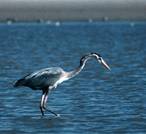|
"Your gateway to
understanding |
Heron

- Largest heron in North America
- Usually seen wading in shallow water looking for prey
- Negatively affected by human contact
Standing at 132cm (52 inches) tall, the great blue heron is the largest heron in North America. It is known to reach 126cm (50 inches) in length, with a 213cm (84 inch) wingspan, and may weigh up to 3.2 kg (7 pounds). Adult herons have bluish gray wings and white heads that have a black streak extending from above the eye to the back of the head. They have a long neck streaked with white, rust-brown, and black, which is generally held in an s-curve. The long yellow beak tapers to a point, and the tail is short. Heron legs are long, thin, and tend to be greenish-yellow in color. Males and females look similar, but males have a puffy black plume of feathers behind their heads, and tend to be slightly larger than females. In flight, a heron’s head is held close to and aligned with the body by a downward bend in the long neck. The long legs trail behind, as this bird flies with strong deliberate wing beats. The call of the heron sounds like a harsh croak.
Great blue herons can be found in a range of habitats including marshes and swamps (including Cicero Swamp), flooded meadows, and along Oneida Lake’s shallow water shoreline, but they always live near bodies of water. Individuals usually forage while standing in water, but will also forage in fields or drop from the air into the water. They feed during night and day, but are most active around dawn and dusk. Herons locate their food by sight, and spear fish and frogs with their long, sharp bill. They also eat insects, snakes, turtles, rodents and small birds. Herons swallow their prey whole, and have been known to choke on prey that is too large.
Great blue herons nest in trees and bushes close to lakes or other wetlands; often in colonies with other heron species. The size of these colonies may range anywhere from 5 to 500 nests per colony, with an average of approximately 160 nests per colony. When driving on NYS Route 298 through Cicero Swamp, heron nests can be spotted in the trees on the east side of the road. Great blues build bulky stick nests, and each female lays three to six pale blue eggs. One brood is raised each year, but if the nest is abandoned or destroyed, the female may lay a replacement set. Both parents feed the young at the nest by regurgitating food, and parent birds have been shown to consume up to four times as much food when they are feeding young chicks than when laying or incubating eggs. Reproduction is negatively affected by human disturbance, and repeated intrusion into nesting areas often results in the abandonment of eggs and chicks, which leads to nest failure.
To learn more about Herons ...
